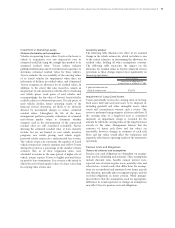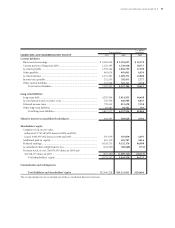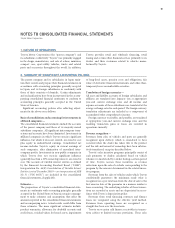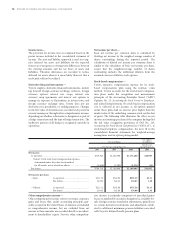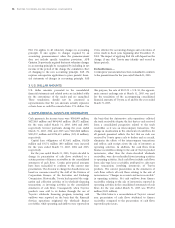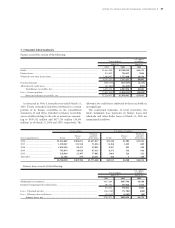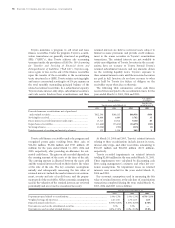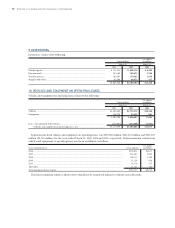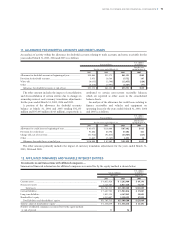Toyota 2005 Annual Report Download - page 85
Download and view the complete annual report
Please find page 85 of the 2005 Toyota annual report below. You can navigate through the pages in the report by either clicking on the pages listed below, or by using the keyword search tool below to find specific information within the annual report.
develops several potential loss scenarios, and reviews
allowance levels to determine whether reserves are consid-
ered adequate to cover the probable range of losses.
The allowance for residual value losses is maintained in
amounts considered by Toyota to be appropriate in
relation to the estimated losses on its owned portfolio.
Upon disposal of the assets, the allowance for residual
losses is adjusted for the difference between the net book
value and the proceeds from sale.
Inventories—
Inventories are valued at cost, not in excess of market, cost
being determined on the “average-cost” basis, except for
the cost of finished products carried by certain subsidiary
companies which is determined on the “specific identifi-
cation” basis or “last-in, first-out” (“LIFO”) basis.
Inventories valued on the LIFO basis totaled ¥190,642
million and ¥233,440 million ($2,174 million) at March
31, 2004 and 2005, respectively. Had the “first-in, first-
out” basis been used for those companies using the LIFO
basis, inventories would have been ¥21,463 million and
¥31,894 million ($297 million) higher than reported at
March 31, 2004 and 2005, respectively.
Property, plant and equipment—
Property, plant and equipment are stated at cost. Major
renewals and improvements are capitalized; minor
replacements, maintenance and repairs are charged to
current operations. Depreciation of property, plant and
equipment is mainly computed on the declining-balance
method for the parent company and Japanese subsidiaries
and on the straight-line method for foreign subsidiary
companies at rates based on estimated useful lives of the
respective assets according to general class, type of
construction and use. The estimated useful lives range
from 3 to 60 years for buildings and from 2 to 20 years for
machinery and equipment.
Vehicles and equipment on operating leases to third
parties are originated by dealers and acquired by certain
consolidated subsidiaries. Such subsidiaries are also the
lessors of certain property that they acquire directly.
Vehicles and equipment on operating leases are depre-
ciated primarily on a straight-line method over the lease
term, generally three years, to the estimated residual value.
Long-lived assets—
Toyota reviews its long-lived assets, including investments
in affiliated companies, for impairment whenever events
or changes in circumstances indicate that the carrying
amount of an asset may not be recoverable. An impairment
loss would be recognized when the carrying amount of an
asset exceeds the estimated undiscounted future cash flows
expected to result from the use of the asset and its eventual
disposition. The amount of the impairment loss to be
recorded is calculated by the excess of the carrying value of
the asset over its fair value. Fair value is determined mainly
using a discounted cash flow valuation method.
Goodwill and intangible assets—
Goodwill is not material to Toyota’s consolidated balance
sheets.
Intangible assets consist mainly of software. Intangible
assets with a definite life are amortized on a straight-line
basis with estimated useful lives mainly of 5 years.
Intangible assets with an indefinite life are tested for
impairment whenever events or circumstances indicate
that a carrying amount of an asset (asset group) may not
be recoverable. An impairment loss would be recognized
when the carrying amount of an asset exceeds the estimated
undiscounted cash flows used in determining the fair
value of the asset. The amount of the impairment loss to
be recorded is generally determined by the difference
between the fair value of the asset using a discounted cash
flow valuation method and the current book value.
Employee benefit obligations—
Toyota has both defined benefit and defined contribution
plans for employees’ retirement benefits. Retirement benefit
obligations are measured by actuarial calculations in accor-
dance with a Statement of Financial Accounting Standard
(“FAS”) No. 87 Employers’ accounting for pensions (“FAS
87”), “Accrued pension and severance costs” are determined
by amounts of obligations, plan assets, unrecognized prior
service costs and unrecognized actuarial gains/losses. A
minimum pension liability is recorded for plans where the
accumulated benefit obligation net of plan assets exceeds
the accrued pension and severance costs.
Environmental matters—
Environmental expenditures relating to current operations
are expensed or capitalized as appropriate. Expenditures
relating to existing conditions caused by past operations,
which do not contribute to current or future revenues, are
expensed. Liabilities for remediation costs are recorded
when they are probable and reasonably estimable,
generally no later than the completion of feasibility studies
or Toyota’s commitment to a plan of action. The cost of
each environmental liability is estimated by using current
technology available and various engineering, financial
and legal specialists within Toyota based on current law.
Such liabilities do not reflect any offset for possible recov-
eries from insurance companies and are not discounted.
There were no material changes in these liabilities for all
periods presented.
NOTES TO CONSOLIDATED FINANCIAL STATEMENTS >83


